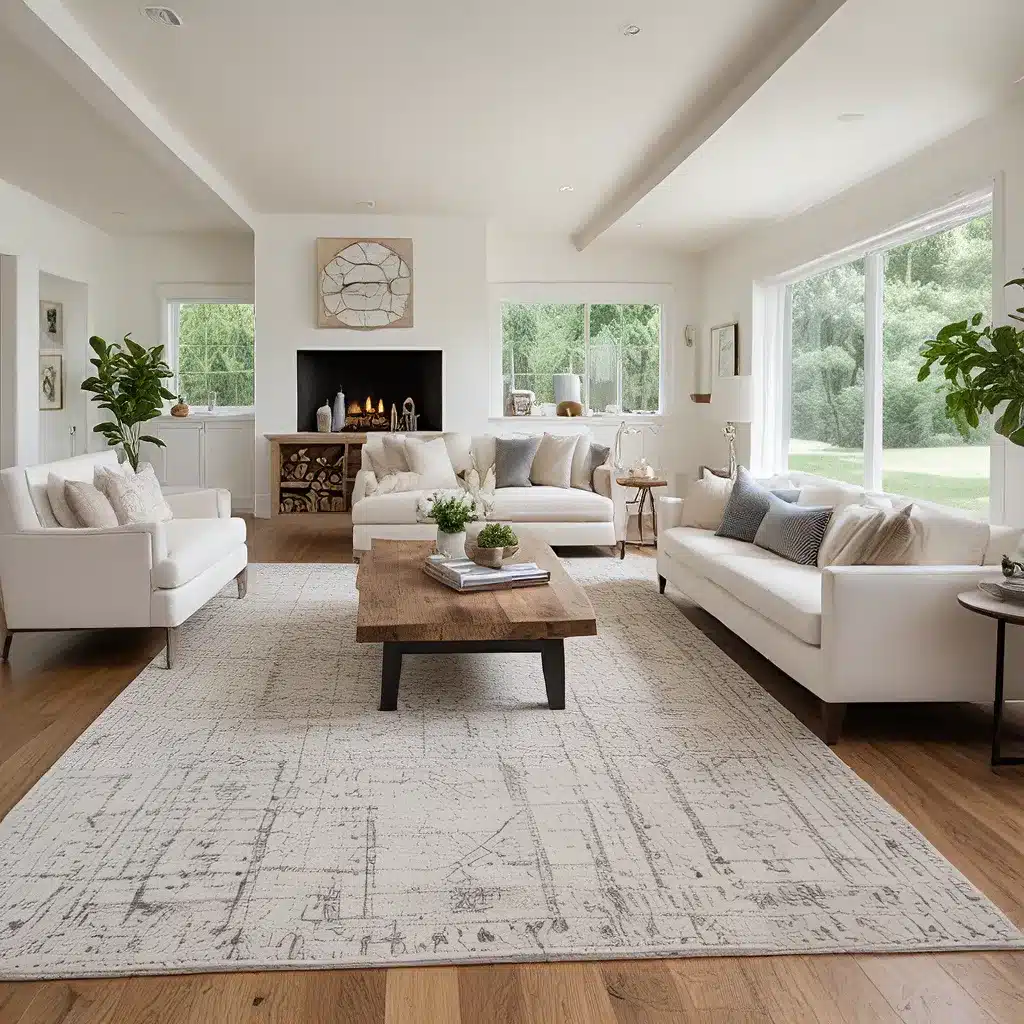Currently Empty: £0.00

Ah, the open floor plan – that coveted design style that promises an airy, free-flowing living space. But with all that glorious openness comes a unique challenge: how do you define the individual zones without disrupting the overall harmony? Fear not, my friends, for I have the secret to conquering this design dilemma – and it all starts with the humble area rug.
Rug Coordination: The Key to Cohesive Open Spaces
As I’ve been redecorating my own home, I’ve had to tackle this very issue. You see, my living room, dining room, and home office all flow seamlessly into one another, creating an expansive, open-concept layout. And let me tell you, finding rugs that play nicely together has been quite the adventure.
Through my research, I’ve learned that the key to rug coordination in an open floor plan lies in two things: color and pattern. By carefully selecting rugs that complement each other in these two areas, you can create a cohesive, visually harmonious space.
The Color Connection
One of the easiest ways to tie your rugs together is by sticking to a consistent color palette. Now, don’t worry, you don’t have to match them perfectly – that would be boring! Instead, look for rugs that share a common color or two, but with varying shades and hues.
For example, if your dining room rug features a beautiful blue and gray pattern, consider a living room rug in a complementary color scheme, like shades of blue and beige. This way, the colors flow seamlessly between the spaces, creating a sense of visual unity.
As the experts at Worthing Court suggest, you can also play with warm and cool tones, pairing rugs in earthy, natural shades like browns and greens with pops of vibrant, cool hues like blues and purples. The key is to find that delicate balance where the colors work together, but each rug still stands out on its own.
Patterns and Textures
Now, let’s talk about patterns. Mixing and matching different rug patterns can be a tricky endeavor, but it’s also where you can really let your creativity shine. The key is to vary the scale of the patterns, so they don’t compete with one another.
For instance, you might choose a living room rug with a bold, large-scale geometric design, while opting for a dining room rug with a more subtle, small-scale pattern. This contrast in scale creates visual interest and keeps the spaces feeling cohesive, yet distinct.
And don’t forget about texture! As Worthing Court suggests, layering different rug materials, like a natural fiber jute rug with a plush, patterned wool rug, can add depth and dimension to your space. This textural interplay helps to define the individual zones while maintaining a harmonious flow.
Neutral Foundations and Layered Looks
Of course, no discussion of rug coordination would be complete without mentioning the power of neutral tones. Neutral rugs, whether in shades of ivory, cream, or beige, serve as the perfect foundation for your open floor plan. Their versatility allows them to seamlessly complement a wide range of color schemes and design styles, creating a timeless, cohesive look.
But don’t be fooled – neutral rugs are anything but boring. In fact, Worthing Court suggests that by layering different textures and patterns within a neutral palette, you can achieve a truly unique and personalized look. Imagine a plush, hand-woven jute rug layered with a bold, geometric patterned rug – the possibilities are endless!
Defining Zones with Rugs
Now, let’s talk about the practical side of using rugs to define spaces in an open floor plan. As the experts at Professional Staging point out, the key is to assess the layout of your space and determine the function of each area. This will help you choose the right rug shape and size to anchor the furniture and visually separate the zones.
For example, a round rug might work best under a dining table, while a rectangular or square rug would be ideal for a living room or family room. And don’t forget about runners – those long, narrow rugs can be the perfect way to define a path or delineate the space between the kitchen and dining area.
Bringing It All Together
When it comes to creating a cohesive, visually stunning open floor plan, the humble area rug is your secret weapon. By carefully coordinating colors, patterns, and textures, you can define the individual zones while maintaining a harmonious flow throughout the space.
So, my fellow design enthusiasts, take a deep breath, channel your inner rug master, and get ready to transform your open-concept living space into a true Sofa Spectacular. With these tips and tricks, you’ll be well on your way to creating a space that’s not only visually stunning but also perfectly tailored to your unique style and needs.

